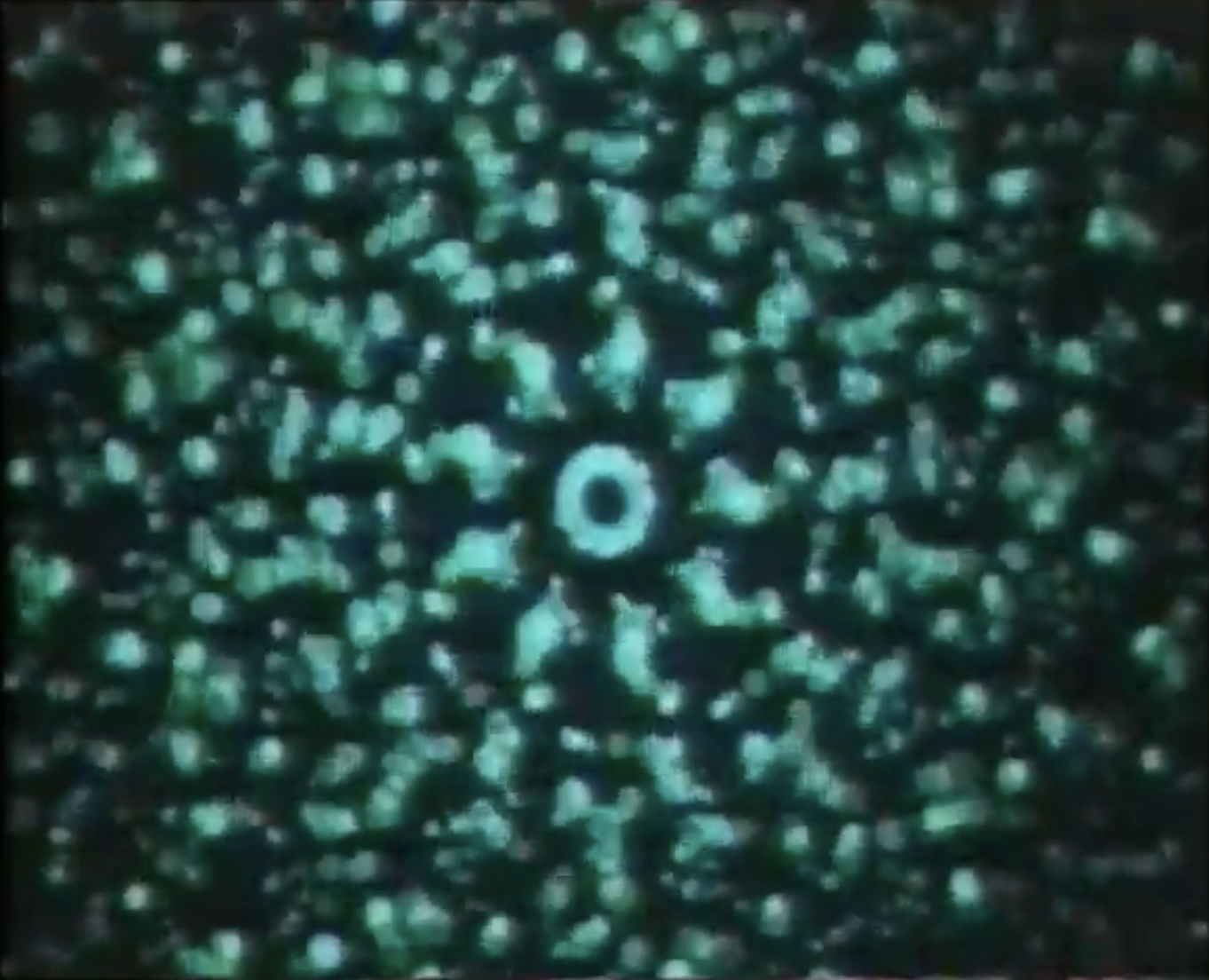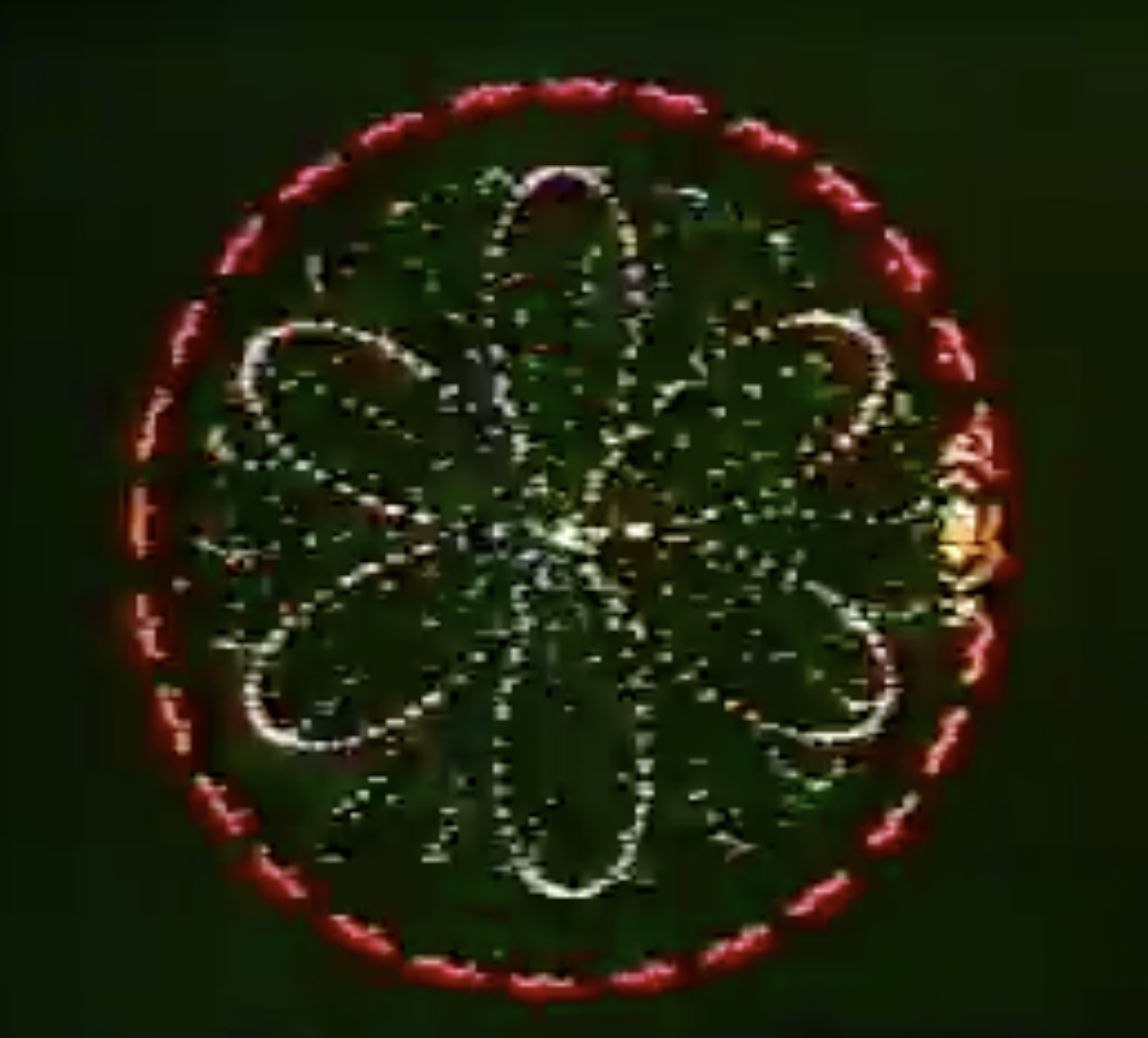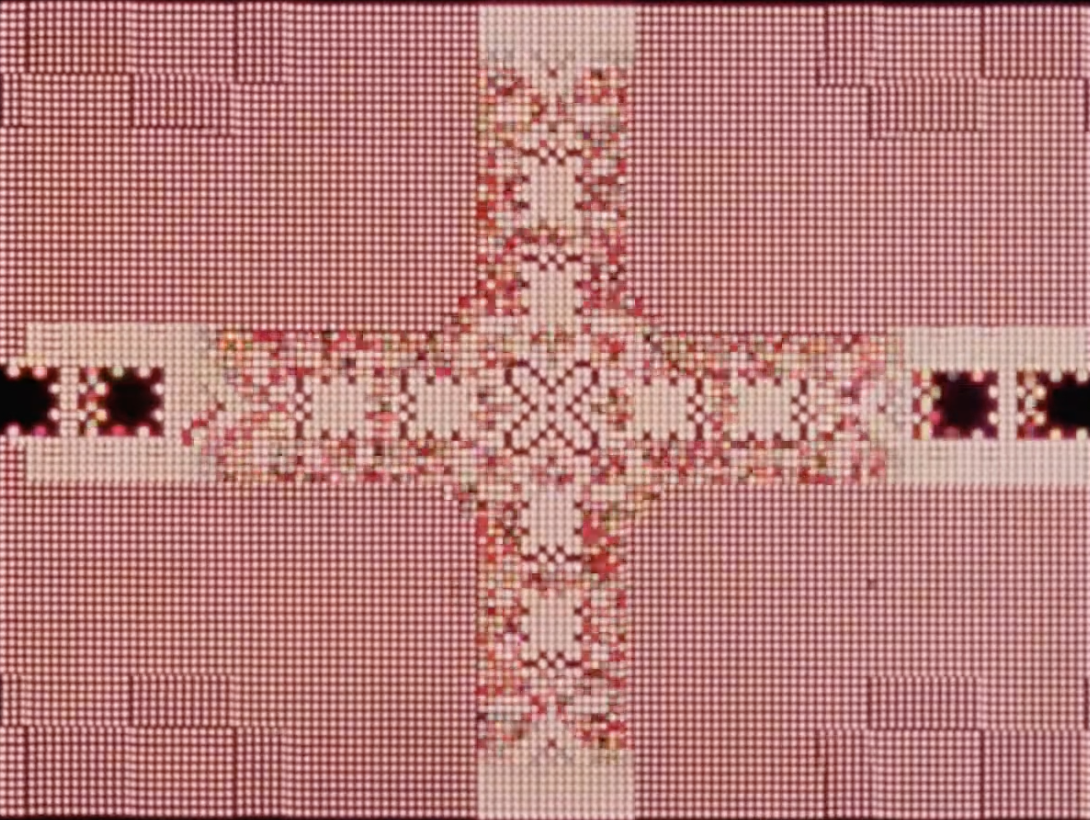No Bad Memories
Studio → Blog
SIGGRAPH 1979 Film and Videotape Retrospective
Posted Thursday, September 25, 2025
Below are excerpts of things I found interesting and/or that I want to look up later while reading the 25-page PDF scan of the program listing for the SIGGRAPH ’79 Film and Videotape Retrospective.
LAPIS 1966
10 minutes; 16mm movie film
By: James Whitney at the filmmaker’s L. A. Studio
Equipment: Mechanical analog machine (prototype)
TERMINAL SELF 1971
8 minutes; 16 mm movie film
By: John Whitney, Jr. at the filmmaker’s L. A. Studio
Equipment: Mechanical analog machine (prototype)
YIN HSIEN 1976
9 minutes; 16 mm movie film
By: Michael Whitney at the filmmaker’s L. A. Studio
Equipment: Motion-controlled optical printer (prototype)
BINARY BIT PATTERNS 1968
3 minutes; 16 mm movie film
By: Michael Whitney and John Whitney, Sr. at Information International
Equipment: FR80 Microfilm Plotter
PERMUTATIONS 1968
7 minutes; 16 mm movie film
By: John Whitney, Sr. at UCLA Health Sciences
Equipment: IBM 2250
FIRST FIG 1974
6 minutes; 16 mm movie film
By: Larry Cube and Gary Imhoff at Cal Arts
Equipment: Univac 1108, SC 4020 Microfilm Plotter
GENESYS c. 1969
25 minutes (short excerpt); 16 mm movie film
By: Ronald Baecker, Eric Martin and Lynn Smith at MIT Lincoln Labs
Equipment: TX-2
Illustrates the use of the Genesys computer animation system.
COMPUTER COLOR GENERATIONS 1972
23 minutes; 16 mm movie film with sound
By: Los Alamos Scientific Laboratory
Equipment: FR80 Microfilm Recorder
A documentary about a technique developed at Los Alamos by which computers can produce color film output at the same cost as black-and-white output. Using computer movie runs as examples, the advantages of color over black and white are discussed.
RON HAYS MUSIC-IMAGE PRESENTATION 1974-1975
50 min; 3/4-inch videotape; sound
By: Ron Hays at WGBH, Boston; Hollywood, CA; and New York City
Equipment: CMX computer editor; PAIK-ABE video synthesizer; Scanimate computer; various video switchers and special effects generators plus computer-controlled animation techniques.
Presentation includes overview of Ron Hays’ work in visual music and multi-media concert situations. Selections include works as seen on public television, feature-length films (Sergeant Pepper’s Lonely Hearts Club Band and Demon Seed) plus television coverage of Star Wars concerts at Montreal Olympic Stadium, 62,000 people in attendance, using lasers and computer imagery. Presentation also includes examples of Emmy award-winning computer graphic title sequences.
MEASURE FOR MEASURE 1968
14 minutes; 3/4-inch videotape
By: Animation and Computer Graphics Staff at the New York Institute of Technology
Equipment: PDP 11s, Evans and Sutherland frame buffers, Three River Graphic Display Processors.
An animated film that pokes fun at our way of measuring. Two kinds of computer animation and conventional animation were intercut.
NYIT SAMPLERS 1976
10 minutes; 35 mm movie film and 3/4-inch videotape
By: The New York Institute of Technology Computer Graphics Laboratory
A collection of animated pieces made at NYIT including 2-d and 3-d animation, special effects, and commercials.
HALLEY FLYBY / TEMPEL 2 RENDEZVOUS 1978
12 minutes; 16 mm movie film; silent
By: Linda M. Lee, James F. Blinn, and Julian E. Gomez at the Jet Propulsion Laboratory
Equipment: Evans and Sutherland Picture System 2, PDP 11/55, Univac 1108, Calcomp Microfilm
A study of a proposed mission to encounter Halley’s Comet and Comet Tempel 2.
PIXILLATION 1970
4 minutes; 16 mm movie film; sound
By: Ken Knowlton and Lillian Schwartz at Bell Laboratories, Murray Hill, NJ
Equipment: SC 4020 Microfilm Plotter, optically added color
Abstract art film.
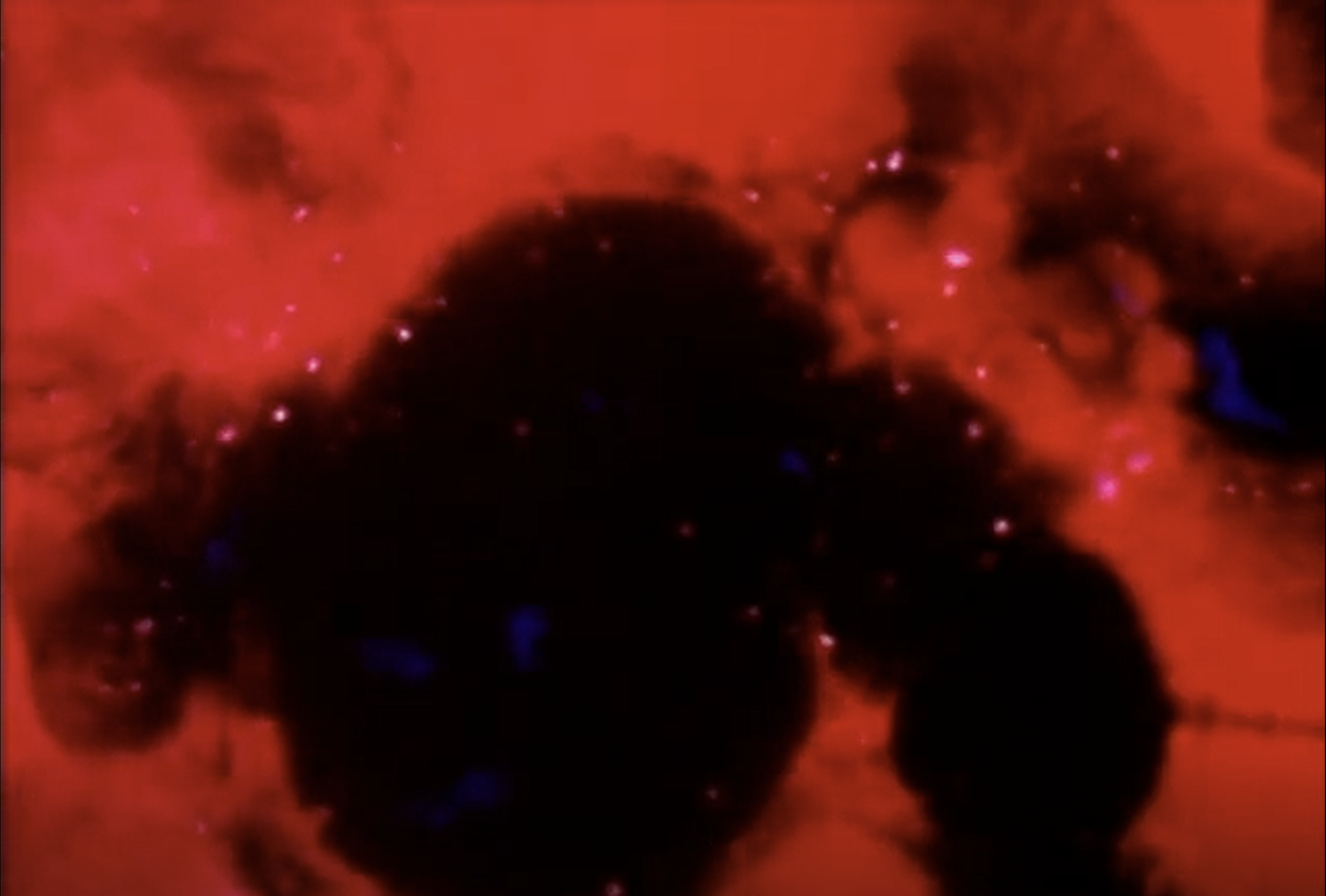
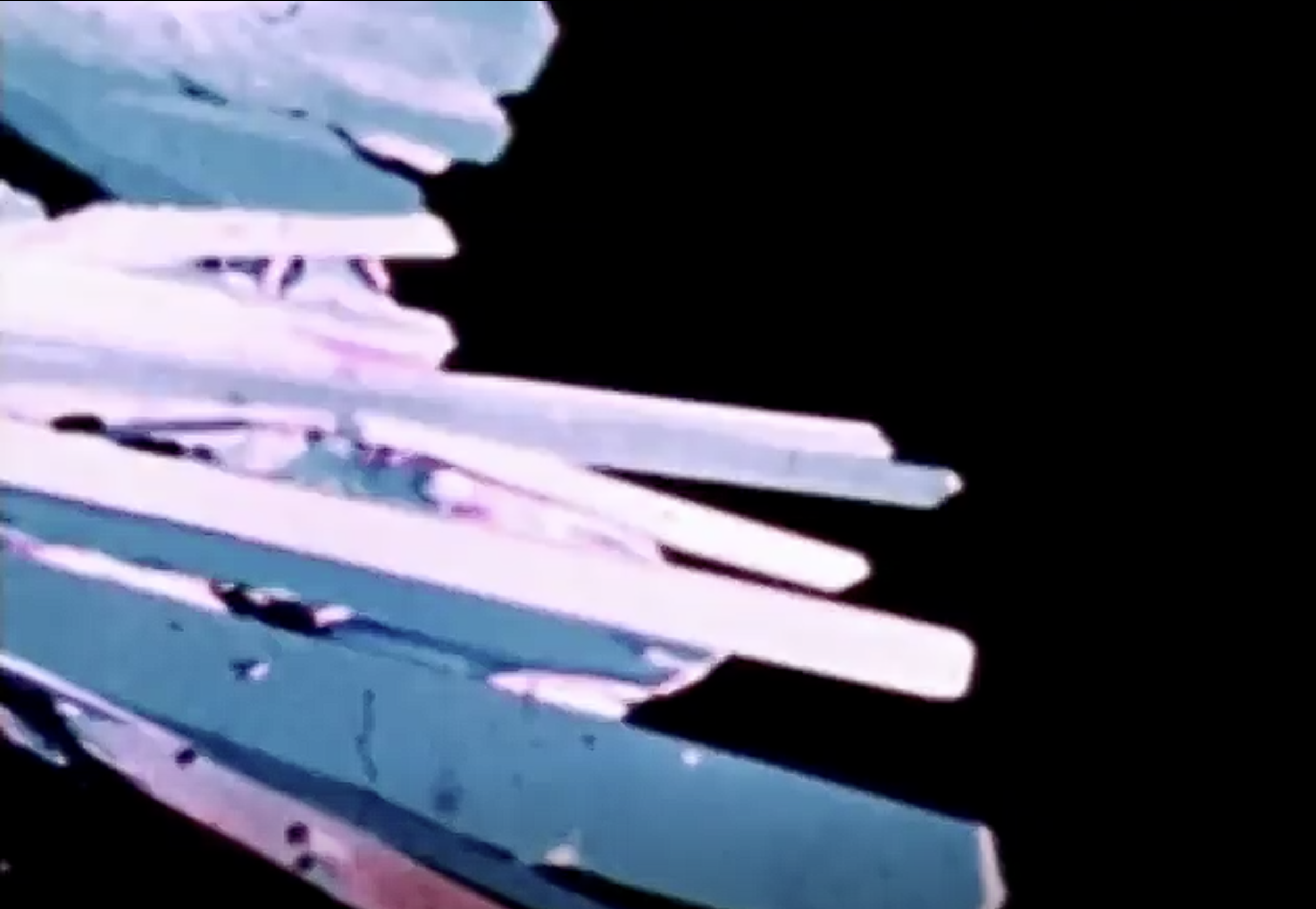
ABSTRACTIONS ON A BEDSHEET 1972
7 minutes; 3/4-inch videotape; sound
By: Bill Etra in Miami, Florida and New York City
Equipment: PDP 11, oscillators
An abstract art work with computer-controlled audio and computer-controlled programmed distortion of a video raster.
OLYMPIAD 1971
3-1/2 minutes; 16 mm movie film; sound
By: Ken Knowlton and Lillian Schwartz at Bell Laboratories, Murray Hill, NJ
Equipment: SC 4020 Microfilm Plotter, optically added color; BEFLIX and EXPLOR software systems.
Abstract art film based on programmed manipulation of running man image.
MS MUFFET 1975
3 minutes; 3/4-inch videotape; sound
By: Lou Katz, Bill Etra, and Louise Etra at Columbia University and Etras’ studio
Equipment: PDP 11/45; Tektronix Scan Converter at 4010 terminal; Rutt-Etra Video Synthesizer; Electronic Associates of Berkeley Video Lab; Synthi Audio Synthesizer.
A real-time interactive art piece, with computer-controlled graphics, colorization, sound and keying effects. The performer interacted with the images as the piece was recorded.
PATCHWORK '71 Prior to 1971
30 minutes; 16 mm movie film; sound
Collected and Edited By: Professor Kent Wilson, Department of Chemistry, University of California, San Diego
Equipment: Many systems. Some sound and optical color added by Dr. Wilson.
A sampler of excerpts from instructional and demo films produced by many of the graphics groups active in the early ’70’s in several universities and laboratories.
THE PRISM SHOWREEL 1976-1979
4 minutes; 3/4-inch videotape
By: Peter Chandler, Tony Diment, and Hayden Young at Imperial College, London; EMI Central Research Labs, Hayes; and EMI A/V.
Equipment: PDP 11/40
Selected title sequences and commercials.
THE ANTICS SHOWREEL 1975-1978
5 minutes; 16 mm movie film
By: Alan Kitching and Colin Emmett at ATLAS Labs
Equipment: FR80
Demonstration of the ANTICS software.
FINITE ELEMENTS 1977
10 minutes; 16 mm movie film
By: Alan Kitching and Colin Emmett at Atlas Lab
Equipment: SD 4020/ANTICS
Royal College of Art. A full length animation.
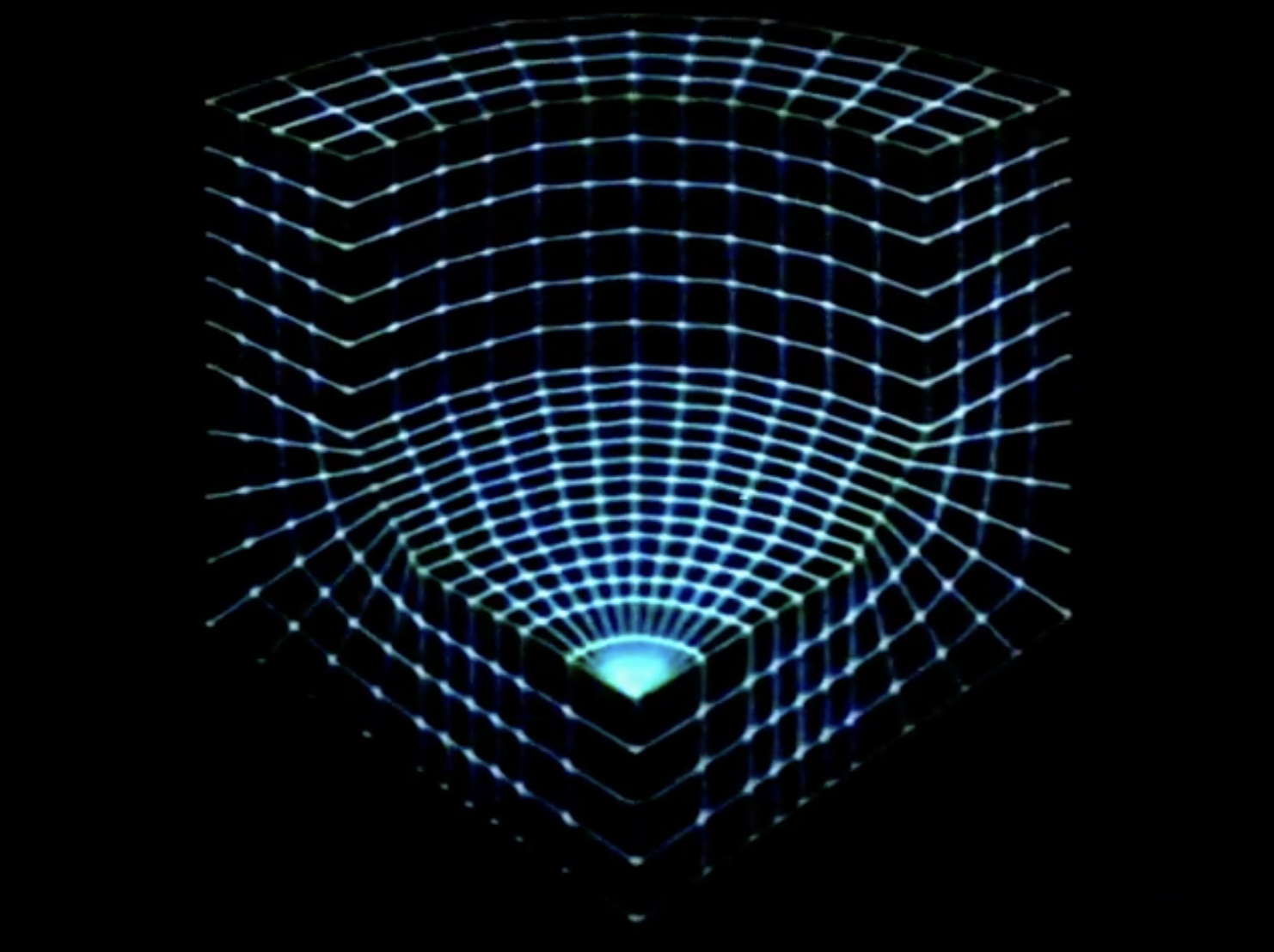
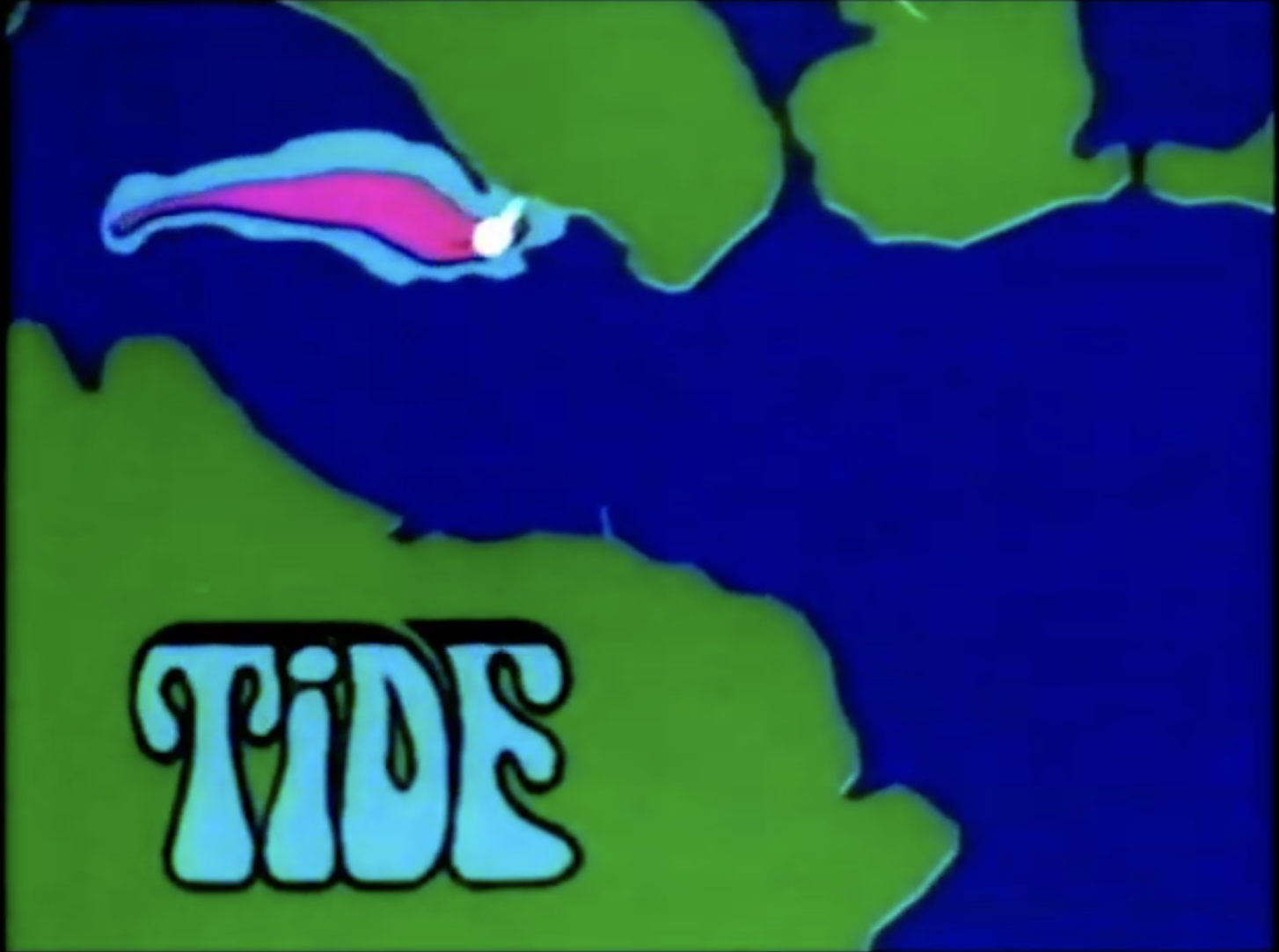
THAMES TV TITLE SEQUENCE 1979
1 minute; 16 mm movie film
By: T. Pritchett at ATLAS Lab
Equipment: FR80/35 mm
THE ALIEN 1979
2 minutes
By: J. Landsdowne, System Simulation at the CAD Centre, ATLAS Lab
Equipment: FR80/35 mm
For 20th Century Fox.
WIRE TREES WITH 4 VECTORS 1978
4 minutes; 3/4 inch video; stereo sound
Audio by: Lief Brush, Stu Pettigrew
Video by: Phil Morton, Guenther Tetz
Black and white performance computer graphics with audio synthesis.
Equipment: UICC GRASS System, Chicago, Sandin Image Processor, Arp Audio Synthesizer
PROGRAM #9: AMATEUR TV 1979
29 minutes, 3/4 inch video; stereo sound
By: Phil Morton, Jane Veeder
Using digital home computer, analog signal processing, and light-weight video equipment to produce a subjective research report on amateur television (2,000-plus U.S. Ham TVers transmitting/receiving personal television from their home bases).
Equipment: Bally Arcade (Home Computer), Sandin Image Processor
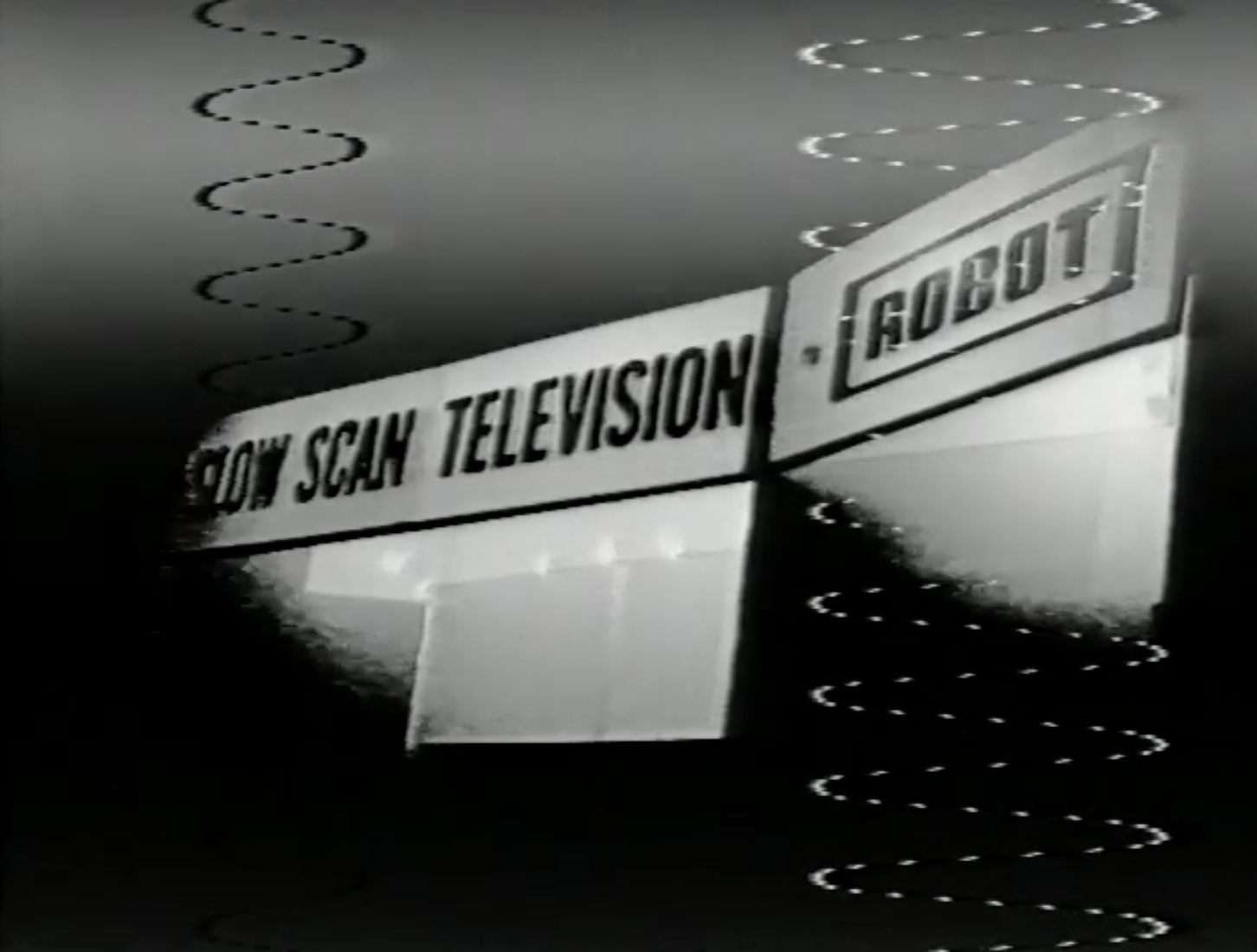

REFERENCE CARRIER 1978
2 minutes; 3/4 inch video; silent
By: Phil Morton
A dynamic black and white analog computer reference signal to be filled in and colored by the user.
Equipment: Sandin Image Processor
LOOP CYCLE 1978
2 minutes; 3/4 inch video; stereo sound
Audio by: Phil Morton, Jane Veeder
Video by: Jane Veeder
Nested electronic multiplication and streaming.
Equipment: Sandin Image Processor
CETACEAN 1978
3 minutes; 3/4 inch video; stereo sound
Audio by: Chip Dodsworth, Barry Bosch
Video by: Chip Dodsworth, Phil Morton
Geographic field collection at Santa Cruz, California and electronic field reprocessing at Chicago, Illinois OCEAN
Equipment: Portable Video Teck, Sandin Image Processor
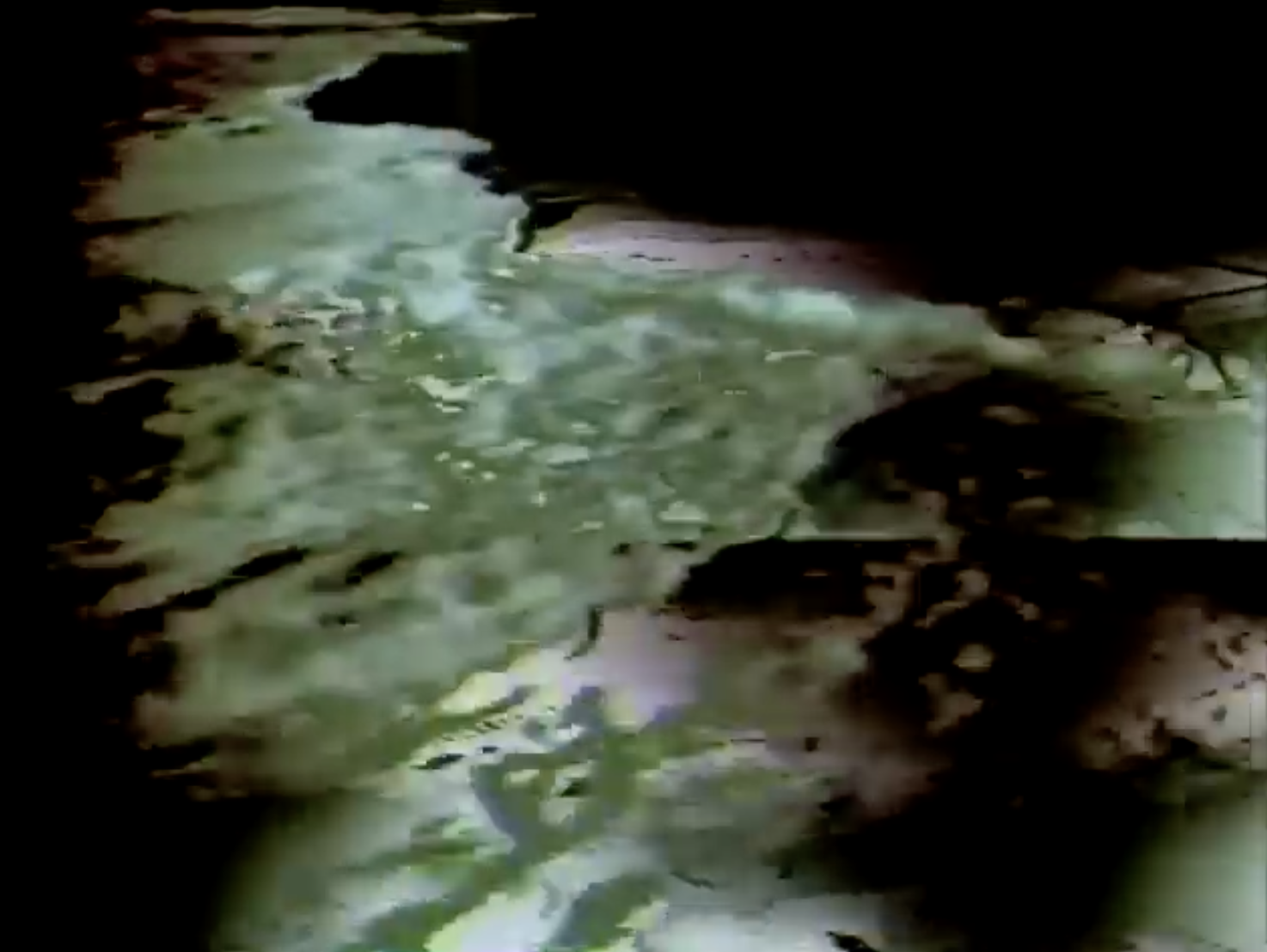
ICRON 1978
11 minutes; 3/4 inch video; stereo sound
By: Bob Snyder
Multiple visual and audio instrument (simultaneous) configuration running on master analog program.
Equipment: EMU Audio Synthesizer, Sandin Image Processor
DATA BURSTS: THIRD MOVE 1978
3 minutes; 3/4 inch video; stereo sound
Audio by: Phil Morton, Bob Snyder
Video by: Phil Morton, Buenther Tetz
Color performance computer graphics with audio synthesis.
Equipment: UICC GRASS System, Sandin Image Processor, EMU Audio Synthesizer
THREE VIEWS OF WATER 1975
6 minutes (excerpt); 3/4" videotape color
By: Dan Sandin
Analog Image Processing of Naturally Collected Material
Equipment: Sandin Analog Image Processor
VAPOR TRAILS 1979
5 minutes (excerpt); 3/4" videotape color
By: Stuart Pettigrew
Direct Video Synthesis
Equipment: Analog Image Processor
NCC/GRASS POOP TAPE 1976
15 minutes; 3/4" videotape color
By: Dan Sandin, Tom DeFanti, Phil Morton
Circle Graphics Habitat GRASS System/Image Processor Demonstration
Equipment: Vector General and Image Processor
FIRST TAPE FROM THE DIGITAL IMAGE COLORIZER 1979
10 minutes; 3/4" videotape color
By: Dan Sandin
The First Card of the Digital Image Processor in its First
Public Showing
Equipment: Sandin Digital Image Colorizer
CHEMISTRY TAPES (EXCERPTS) 1973-77
5 minutes; 3/4" videotape color
By: Circle Graphics Inhabitants
Sample Tape of Rotating Molecules, etc.
Equipment: Vector General and Sandin Image Processor
SPIRAL 3 1978
10 minutes; 3/4" videotape color
By: Tom DeFanti, Phil Morton, Dan Sandin, Bob Snyder,
Jane Veeder and Rylin Harris (dance)
Performance Piece with Digital and Analog Computer Graphics
and Dance
Equipment: Vector General and Sandin Image Processor
L6 - PART I 1966
1966 15 minutes; 16 mm movie film
By: Ken Knowlton at Bell Labs
Equipment: Stromberg DatagraphiX 4060 Microfilm Recorder
Introduction to List Processing Language L6.
POEMFIELD #2 1967
8 minutes; 16 mm movie film
By: Ken Knowlton and Stan Van Der Beek at Bell Labs
Equipment: Stromberg DatagraphiX 4060 Microfilm Recorder
Computer art film. Concrete poetry.
UFO'S 1979
3 minutes; 16 mm movie film
By: Ken Knowlton and Lillian Schwartz at Bell Labs
Equipment: Stromberg DatagraphiX 4060 Microfilm Recorder
Computer art.
METAMORPHOSIS 1973
10 minutes; 16 mm movie film
By: Ken Knowlton and Lillian Schwartz at Bell Labs
Equipment: Home-built frame buffer and color television
Computer art.
CRYSTAL GROWTH 1978
1978 10 minutes; 16 mm movie film
By: Ken Knowlton, George Gilmer, and Mary Shugard at Bell Labs
Equipment: Home-built frame buffer and color television
Simulation of crystal growth.
BAOBAB 1979
1979 20 minutes; 16 mm movie film
By: Ken Knowlton and Emmanuel Ghent
Equipment: Home-built frame buffer and color television
Computer art.
WIPEPOEM 1976
6 minutes; 3/4-inch videotape
By: Patsy Scala at Syracuse University
Equipment: DEC 10, Grass Valley television switcher, refracted laser light
Abstract attempts to sensualize computer imagery through use of color, movement, and the interplay of negative and positive space.
SCOPE II 1976
5 minutes; 3/4-inch videotape
By: Patsy Scala at Syracuse University
Equipment: DEC 10,Grass Valley television switcher, refracted laser light
Abstract attempts to sensualize computer imagery through use of color, movement, and the interplay of negative and positive space.
SYRACUSE CABLE SYSTEMS-COMPUTER VIDEO MUSIC CHANNEL 1979
30 minutes; 3/4-inch videotape
By: Programming Department Staff at Syracuse Cable Systems
Equipment: Apple II
Part of a 24 hour-a-day computer graphics cable channel, possibly the first of its kind in this country.
AND-HANDS 1962
2 minutes; 16 mm movie film
By: Stan Van Der Beek at Computation Center, University of Texas, Austin
Equipment: CDC 6600, light pen and keyboard
Drawings of geometric shapes (hands and heads). Use of type and limited animation.
MAN AND HIS WORLD 1968
1 minute; 16 mm movie film
By: Stan Van Der Beek and Ken Knowlton
Equipment: Stromberg Carlson 4020; BEFLIX software system
Exploration of graphics and patterns color experiments from black and white originals.
WHO-HOO-RAYS 1967-1970
7 minutes; 16 mm movie film
By: Stan Van Der Beek at home
Equipment: Home-made modifications to standard oscilloscope.
Radio programs are modified into abstract images, filmed in black and white, and color printed by "Brown/Olvey".
POEMFIELD #7 1969
5 minutes; 16 mm movie film
By: Stan Van Der Beek and Ken Knowlton at Bell Laboratories, Murray Hill, NJ
Equipment: Stromberg Carlson 4020
One of a series of computer poems that explore the graphic possibilities of typography and patterns. Made from black and white film printed in color by "Brown/Olvey".
COLLIDEOSCOPE 1966
4 minutes; 16 mm movie film
By: Stan Van Der Beek, Ken Knowlton, and Carol Bosche at Bell Laboratories, Murray Hill, NJ
Equipment: Stromberg Carlson 4020
Experiments with text and typography. A short poem is transformed into a series of patterns and optical illusions.
SYMMETRIKS 1972
7 minutes; 16 mm movie film
By: Stan Van Der Beek and Wade Shaw
Equipment: Light pen
Drawings that are multi-copied by the computer. An experiment to make color from a black and white film.
EUCLIDEAN ILLUSIONS 1979
11 minutes; 16 mm movie film
By: Stan Van Der Beek and Richard Weinberg at NASA, Houston, Texas
Geometric shapes penetrate each other and move through space. An unexpected moment in geometric order.
